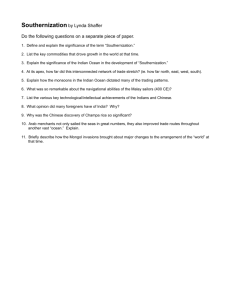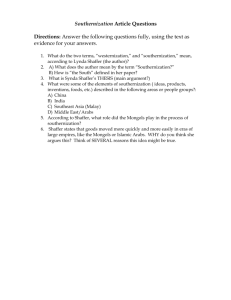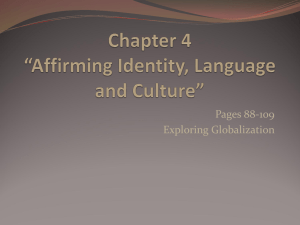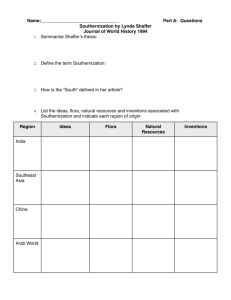View PDF
advertisement
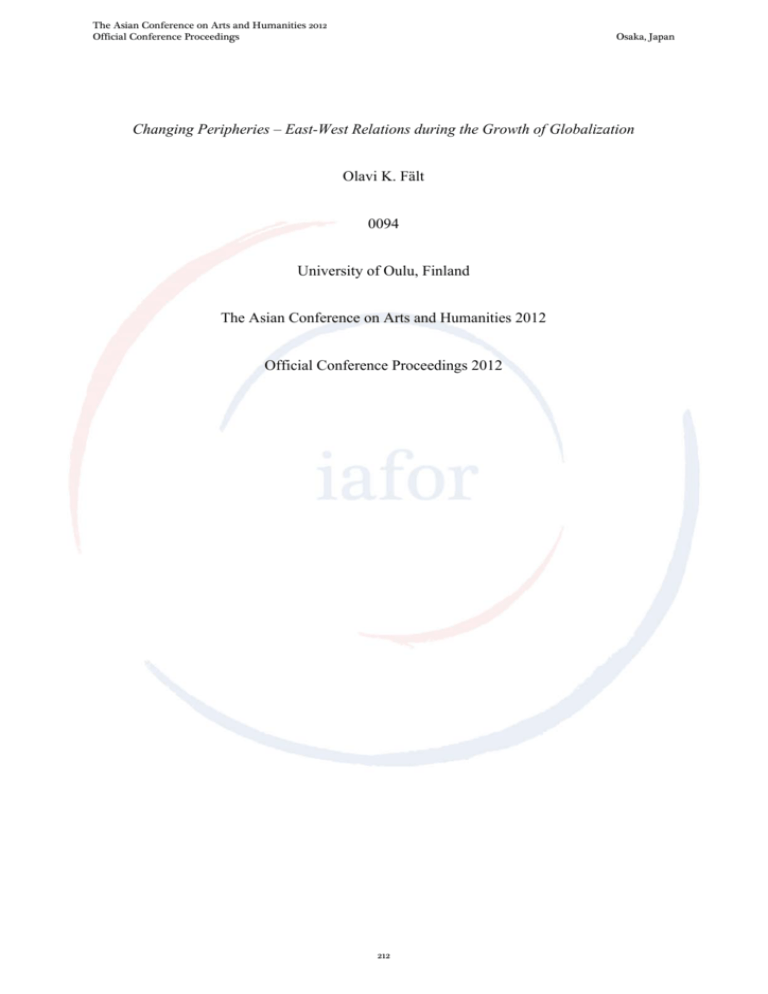
The Asian Conference on Arts and Humanities 2012 Official Conference Proceedings Osaka, Japan Changing Peripheries – East-West Relations during the Growth of Globalization Olavi K. Fält 0094 University of Oulu, Finland The Asian Conference on Arts and Humanities 2012 Official Conference Proceedings 2012 212 The Asian Conference on Arts and Humanities 2012 Official Conference Proceedings Osaka, Japan Introduction In this article I examine why Western culture achieved a position of hegemony in global development in the 1800s and why non-Western cultures, particularly Arabic, Indian, and Chinese cultures, did not reach the same position. I examine the question through the growth of globalization by assessing the political, cultural, and economic factors that affected it during different periods. I have placed the starting point of my analysis at around 200 BC, when the growth of globalization clearly began to accelerate. The growth of globalization as such can be considered to have begun already when man faced the need to spread beyond his original home. Robert P. Clark explains this need with the theory of entropy, according to which it has been necessary for mankind to spread everywhere in the world. This has been a consequence of the perpetual struggle to satisfy the needs of a society that is continuously expanding and becoming more complex. The model he presents is based on the second law of thermodynamics, according to which entropy constantly increases in every closed system. The tendency in all human systems is toward energy loss and entropy. Energy does not disappear as such, but in practice it can no longer be reused for man’s future needs. Cultures have flourished by spreading their sphere of influence, whereupon entropy and energy loss have been transferred elsewhere. The more complicated the system in question, the more it needs resources like energy and material to grow or even to maintain order. To survive, a complex system needs a constantly expanding network through which it can transfer lurking disorder elsewhere.1 Connections between Three Centers As I already mentioned, in the third century the growth of globalization entered a new phase with the simultaneous birth of large state and cultural entities that began to form increasingly constant trade connections with each other. The Hellenistic culture and the rising Roman world power in the West created political and cultural unity. On the other hand, the Maurya kingdom united a large portion of South Asia by creating a political system for a common culture called the Indian culture. At the same time the Qin and Han dynasties united China and created a uniform area of Chinese culture from local cultures.2 Earlier contacts between these regions by land and sea had been quite coincidental, but as the societies developed and became more complex, in accordance with the theory of entropy, new needs arose that could not be fully satisfied regionally. Therefore, around 200 BC regular trading began by land from China via Central Asia to the Mediterranean Sea and by sea in the most important parts of the region extending from Japan to Morocco. Trading became very regular especially from the Red Sea and the Persian Gulf to India, from India to Southeast Asia, and from Southeast Asia to China and Japan. The trade routes from the Mediterranean Sea to East Asia survived, despite the disintegration 1 Robert P. Clark, The Global Imperative. An Interpretive History of the Spread of Humankind. Global History Series. Bruce Mazlish, Carol Gluck, and Raymond Grews, Series Editors. Westview Press 1997, 4–8. 2 Philip D. Curtin, Cross-cultural trade in world-history. Cambridge University Press. First Published 1984. Reprinted 1992, 90. 213 The Asian Conference on Arts and Humanities 2012 Official Conference Proceedings Osaka, Japan of the Roman Empire (476) and the Han dynasty (220). At the end of the millennium they were strengthened by the power of the Tang dynasty (618–906) in China and the Abbasid caliphate (750–1258) in Baghdad.3 At the same time the westernmost part of the trade route lost its significance, because along with the disintegration of the Roman Empire, the relative position of the western part of Europe compared with the Eastern world began to weaken quickly. The Roman Empire as such endured as East Rome until 1453. Southernization in the History of Globalization Lynda Shaffer has called the thousand-year period beginning around AD 500 the period of southernization in the history of globalization. To her, southernization as a term is analogous to westernization. Westernization refers to the development that initially took place in Western Europe and gradually spread to other areas and changed them. In the same way southernization began in South Asia and later spread elsewhere, bringing with it great changes. Southernization had advanced quite far in South Asia in the fifth century. At the same time it spread to China and in the eighth century also to the Muslim caliphates. Around 1200 it also began to affect the Christian regions around the Mediterranean Sea. As a result of southernization a southern zone that was much richer than the northern areas was born. According to Shaffer, it could even be said that southernization laid the groundwork for westernization.4 Southernization was the result of development that had taken place in many parts of southern Asia, the Indian peninsula, and Southeast Asia. Perhaps the earliest sign of this development was cotton farming and production of cotton textiles for exporting. Cotton farming was first adopted in the Indus River valley around 2300-1760 BC. Egypt became an important market area for Indian cotton during the first century AD. From then on the demand for cotton grew quickly in the Mediterranean area and East Africa, and already by the fourth century it was marketed in Southeast Asia. During the next thousand years the Indian cotton trade grew constantly, and perhaps a little exaggeratedly it has even been said that as late as the mid-1700s, India clothed the entire world. Only after the Industrial Revolution did Britain supersede India as a producer of cotton.5 Another significant factor in southernization was gold and the search for it. At first Siberia was the main source of gold, but later the nomads’ travels in Central Asia began to interfere with trade between Siberia and India so much that gold began to be searched for elsewhere. The Indians became especially interested in the Malay Peninsula and the Indonesian archipelago, from which they began bringing gold to India. Most likely it was the search for gold that also led the Indians to the east coast of Africa.6 3 Curtin 1992, 90–91. Lynda Shaffer, “Southernization”. Journal of World History. Volume 5, Number 1, Spring 1994, 1–2. 5 Shaffer 1994, 2–3. 6 Shaffer 1994, 3. 4 214 The Asian Conference on Arts and Humanities 2012 Official Conference Proceedings Osaka, Japan Sailors of different nationalities gradually began to bind together the coastal areas of the ”Southern Sea”. ”Southern Sea” was the name the Chinese gave to the large ocean area extending from the South China Sea to the east coast of Africa. Malayan sailors, in particular, excelled in early long-distance sailing. For example, they reached the east coast of Africa by the first century AD. Apparently they also started the long-distance trade in Southern spices. It is known that just before the Christian era they already transported cinnamon from the harbors of South China to East Africa and the Red Sea.7 During the first century AD, southern India began to produce large amounts of pepper for the Mediterranean region. Around AD 350 the Indians discovered how to crystallize sugar, after which it became a significant export article. The Indians also laid the groundwork for modern mathematics with Arabian numerals, or as the Arabians called them, Hindu numerals. With these significant steps of progress India achieved fame as a land of marvels that lasted for centuries.8 It must also be remembered that later Indian steel was the best in the world for several centuries, all the way to the 1800s.9 The Arabs also played a significant role in southernization. In the 600s and 700s the Arabs, having embraced a new religion – Islam – conquered the eastern and southern coastal areas of the Mediterranean Sea, Spain, and the Turkish-Iranian regions of Central Asia. Thereafter the important sea trade route from the Persian Gulf to China was under their control until the 1500s. Apparently they were also the first to effectively utilize the new Chinese compass invention on their ocean voyages. Due to their geographic position, the Arabs also brought many significant inventions from India first to the Near East. They included new crops like cotton and sugar as well as Indian mathematics. To grow sugar, the Arabs were the first to begin acquiring large numbers of slaves from Africa.10 After the fall of the Han dynasty, the significance of Buddhism, which had spread from India to China, continued to strengthen. New Buddhist monasteries brought even more exchange of culture between regions. During the Tang dynasty (618–906), when the influence of Buddhism was especially great, two significant technological inventions were made in China – printing and gunpowder. Flaming arrows, rockets, and bombs thrown by catapults were used already in the 900s. In the beginning of the Song dynasties (960–1279) the Chinese had already developed a quite functional compass, which further increased sea trade, as mentioned earlier. As a consequence the towns on the southern coast of China became significant centers of sea trading. At that time China’s most important export products were silk, porcelain, and iron products. Not one country was able to reach the level of iron production of Song-China until the Industrial Revolution in Britain in the 1700s.11 7 Shaffer 1994, 4. Shaffer 1994, 3–8. 9 John M. Hobson, The Eastern Origins of Western Civilisation. Cambridge University Press 2004, 211. 10 Shaffer 1994, 12–14. 11 Shaffer 1994, 8–12. 8 215 The Asian Conference on Arts and Humanities 2012 Official Conference Proceedings Osaka, Japan By the 1200s southernization had created a prosperous South that extended from China to the Muslim Mediterranean region. Many important basic aspects of southernization were related to this latitude. Cotton usually did not grow above the 40th parallel, sugar, cinnamon, and pepper were tropical or subtropical varieties, and some spices only grew on certain tropical islands. Thus, the southern parts of Asia and the Muslim Mediterranean region were able to enjoy the benefits obtained from them for several centuries, while the more northerly regions were not able to share the wealth obtained from this profitable farming.12 This situation began to change with the appearance of the Mongol conquerors in the 1200s. They created the world’s largest kingdom of all time, whose influence reached at best from the Pacific Ocean to the remotest corners of the Gulf of Bothnia. When they gained control of the land routes between Europe and Asia, new connections between Western Europe and the southernized regions of Asia were created. As a result of these contacts the Christian Mediterranean region also gradually began to become southernized. From the perspective of Western Europe, the most important innovations were the Chinese inventions – the compass, printing, and gunpowder. The Arabs most likely brought the compass to the Mediterranean region in the late 1100s or early 1200s. Block printing, gunpowder, and cannons apparently first came to Italy from the Mongol regions in the 1300s, as did the Black Death.13 Globalization Led by the Chinese and Islamic Nations As late as the beginning of the 1400s it appeared that future globalization would be led by the Chinese and Islamic nations. When the influence of the Mongols weakened, the significance of Islam was even further strengthened, as the Southeast Asian nations from the Malay Peninsula to the southern Philippines turned to the Islamic faith. Islam also spread to Eastern Europe when the Turks conquered Constantinople in 1453.14 At the same time China’s influence was also growing, as the new Chinese Ming dynasty (1368–1644) decided to send large naval expeditions to the surrounding areas after the fall of the Mongol-led Yuan dynasty (1271/1279–1368). The purpose of these naval expeditions was to indicate the power and greatness of the dynasty, tax the nations in the Indian Ocean region as a sign of Chinese supremacy, and acquire exotic, valuable products. The naval expeditions began in 1405 and ended in 1433. Altogether seven expeditions were sent during that time. Until then, nowhere in the world had such a great display of maritime technology been seen.15 The largest vessels had nine masts and were about 120 meters long and 45 meters wide, i.e. they are among the largest sailing ships in the world throughout all time. In comparison, Columbus’s flagship Santa Maria was about 27 meters long. The naval divisions also had many kinds of special vessels, such as water tankers. At their largest, 12 Shaffer 1994, 15–16. Shaffer 1994, 16–18. 14 Shaffer 1994, 19. 15 Clark 1997, 69. 13 216 The Asian Conference on Arts and Humanities 2012 Official Conference Proceedings Osaka, Japan the fleets consisted of over 300 vessels and around 30,000 men. Nevertheless, after 1433 the expeditions were ended by Imperial decrees intended to turn China’s focus inward. Finally, a decree in 1551 forbade seafaring with a multi-mast vessel for any reason.16 Studies have given much consideration to the reasons for China’s new policy. Apparently there were many reasons. First of all, for centuries the Confucians had criticized the significant role of trade and traders in Chinese society. Secondly, there had been a continuous power struggle between eunuchs and Confucian scholars. The eunuchs had supported and led the naval expeditions, while the Confucian scholars had opposed them. Thirdly, according to the Chinese elite, the country had no broader need for foreign products. Trade was only important in acquiring gold, silver, and rare, exotic products. Fourth, the Ming dynasty’s more or less continuous war against the Mongols in the northern border regions consumed large amounts of national wealth. Fifth, the new 3200kilometer-long Great Canal required a significant number of transport vessels, which changed the focus of shipbuilding.17 As the construction of seaworthy ships ended, China gradually lost her leading position in naval technology. When the global system developed, it was led not by China, but by Europe’s western states – Portugal, Spain, the Netherlands, France, and Great Britain. One of history’s most interesting coincidences was China’s gradual withdrawal from the world’s stage at the same time as Portugal and Spain began to create a new basis for a global society and economy.18 When European vessels reached Asia, no power was any longer able to resist them. The Portuguese destroyed the Arabs’ naval power in the Indian waters in fifteen years.19 Westernization in the History of Globalization What, then, was the reason for this great change in world history? Starting from the end of the first millennium, Europe had experienced significant population growth. The population had quickly grown from 40 million to 80 million by the early 1300s. In spite of the immense rate of mortality caused by the Black Death, Europe’s population exceeded 90 million by the beginning of the 1500s.20 This caused repeated famines in many richly populated areas. It seemed that the people had no other alternative in the future than a continuous cycle of famine, death, population growth, famine, death, population growth, and so on. Even improved agricultural methods could not solve Europe’s population crisis.21 It required new methods, especially exploitation of new areas outside of Europe, in 16 Clark 1997, 69–70. Clark 1997, 70–71. 18 Clark 1997, 71. 19 European Expansion and the Counter-example of Asia, 1300–1600. Edited by Joseph R. Levenson. Prentice-Hall, Inc., Englewood Cliffs, N.J. 1967, 17–29. 20 Clive Ponting, A New Green History of the World. The Environment and the Collapse of Great Civilizations. Penguin Books 2007, 95–113. 21 Clark 1997, 71–73. 17 217 The Asian Conference on Arts and Humanities 2012 Official Conference Proceedings Osaka, Japan accordance with the theory of entropy. There it was possible to obtain new types of food, such as corn and potatoes, and new places to live to alleviate the population pressure. In this situation the Turks’ conquering of Constantinople was of conclusive significance. It substantially increased the cost of trade in the Mediterranean region and Asia. The fall of Mongol power at the end of the 1300s had already nearly completely closed the land connection – the traditional Silk Road. Sea connections again were affected by the Turks’ policy of high tariffs in the harbors they controlled. Therefore, the Portuguese and Spanish increasingly enthusiastically searched for new connections to the East. The Portuguese succeeded when, led by Vasco da Gama, they rounded Africa in 1498. The Spanish, led by Columbus, sailed west, first to America in 1492 and from there eventually to Asia.22 The importance of pepper, in particular, in the life of Europeans was behind the early voyages of exploration. Pepper was a safe, easy way to make meat and fish, which had to be heavily salted for long-term preservation, edible. The population pressure dramatically increased the demand for pepper in Europe in the 1400s at the same time as connections to the East quickly became more difficult. Of course, valuable metals – gold and silver – were also important lures for voyages of exploration. For example, when Columbus set out on his voyage, he planned on funding the Crusades with the coming riches. The Christian faith itself was of significance, i.e. the goal was to convert pagan nations to Christianity.23 By utilizing new foods from the West and East, using Western precious metal resources, gold and silver, and adopting Chinese and Arabic technical inventions, the Europeans were prepared to create a new global commercial network and rise to a leading position in the world. They were skillful in borrowing and mimicking new technology and developing it further. The Europeans were also able to successfully combine science and technology.24 Thus, the former periphery gradually became a new center and the old centers became new peripheries. Real intercontinental world trade began after the Spanish established Manila in the Philippines in 1571.25 On the contrary, the Chinese and Indians as residents of large southern peninsulas did not need new foods or inventions from other areas or other cultures in the same way as the Western Europeans did. At that stage their own resources sufficed. Therefore, they were not interested in large-scale trading like the Europeans were, nor were they eager to sail afar to see or discover new areas in the world. Contrarily, the Europeans had reached the limits of their resources. The only possible solution appeared to be to attempt to bring resources from other areas. From the 1500s on the Europeans were able to exploit broad new areas – future periphery – to acquire needed resources with which they were later able to fuel their historic expansion. 22 Clark 1997, 71–75. Clark 1997, 75–77. 24 Levenson (ed.) 1967, 17–22. 25 Andre Gunder Frank, ReOrient. Global Economy in the Asian Age. University of California press. Berkeley and Los Angeles, California 1998, 65. 23 218 The Asian Conference on Arts and Humanities 2012 Official Conference Proceedings Osaka, Japan However, the change was slow and incremental. As late as the 1700s China was still the center of the world’s silver trade. At that time the Europeans admired China and Chinese culture so much that as a consequence a wave of fashionable Chinese culture passed over Europe. In the early 1800s China and India were still the world’s most prosperous nations.26 The Chinese, Indians, and Japanese were able to control their relationship with the Europeans on their own terms until the 1800s. However, the situation began to change in the very last decades of the 1700s. Dwindling of European trading profits both in and outside of Europe in the middle of the century had accelerated the Industrial Revolution and also the political revolutions in North America and France. At the same time there was a weakening of economies and societal structures in Asia, which offered the Europeans even more leeway in exploiting their own political and economic goals in the area. Thus, the end of the 1700s can be considered a significant turning point in East-West relations.27 The best example of this was Great Britain’s success. Having gotten an even stronger hold on India, she was able to exploit Indian opium by forcing China to ”become more open” to trading with the West. The last turning point was China’s defeat under Britain in the Opium War in 1839–1842 and the supremacy that Britain achieved in India. After that the Europeans rose to a leading position in the world and the former centers – the Islamic world, India, and China – became peripheries. It should be noted, though, that the Europeans did not seek to change the world only because the resources available to them made it possible. They also sought to change the world because they believed it was a task given to them. The Europeans viewed their own identity in such a way that the imperialistic policy they pursued was also a morally correct policy.28 Conclusions Success in exploiting external resources under severe population pressure was the basis on which Europe’s rise to become a leading power in the growth of globalization was built. At the same time, however, Europe also offered a model and tools for other cultures to follow. Japan was the first to grasp this possibility already at the end of the 1800s, at the peak of the era of European imperialism. She was able to at least partly avoid imperialism by intensively renewing her whole society according to the European and partly also Chinese models deemed best. Japan’s victorious wars against China (1894– 1895) and Russia (1904-1905) and thereby her rise to become one of the world’s leading states was proof of the success of the renewals. Thus, Japan was the first Eastern nation to effectively exploit external global resources in order to develop and strengthen her society. Now India and especially China are seeking to do the same by exploiting global 26 Yoshimasa Nishimura, “Japan’s Place as a Peripheral State”. JapanEcho. Volume 35, Number 2, April 2008, 50–55. 27 Hobson 2004, 294–322. 28 Ibid. 219 The Asian Conference on Arts and Humanities 2012 Official Conference Proceedings Osaka, Japan innovations and raw materials. Summary Olavi K. Fält: East-West relations during the growth of globalization In this article I examine why Western culture achieved a position of hegemony in global development in the 1800s and why non-Western cultures, particularly Arabic, Indian, and Chinese cultures, did not reach the same position. I examine the question through the growth of globalization by assessing the political, cultural, and economic factors affecting it during different periods. I have placed the starting point of my analysis at around 200 B.C., when the growth of globalization began to clearly accelerate. In my analysis I utilize Robert P. Clark’s entropy theory, which is based on the second fundamental principle of thermodynamics. According to Clark, cultures have flourished by extending their sphere of influence, whereupon disorder and loss of energy have been moved elsewhere. The more complex the system in question, the more it needs resources, like energy and material, to grow or to even maintain order. In order to endure, a complex system requires a continuously expanding network through which it can move lurking disorder elsewhere. In East-West relations, the West became a periphery as a result of the fall of the Roman Empire. The two other earlier centers, India and China, preserved their positions. The thousand-year period beginning in the 500s was a period of so-called southernization in the history of globalization. During that time the Islamic world, India, and China led the process of globalization to such an extent that by the 1400s it appeared nothing would be able to undermine their dominance, even in the future. Nevertheless, Western Europe had been able to adopt enough technical inventions produced by southernization that when population pressure in the 1400s forced it to search for external resources in order to survive, it had the prerequisites to do so. On the other hand, there was no need to utilize external resources to the same extent in the core areas of southernization. In practice, this gradually led to a situation in which Western Europe, which had very successfully utilized the resources, rose to a leading position in the world in the 1800s. At the same time Europe also served as a model for other cultures in the utilization of external resources. Japan was the first to implement the model already in the 1800s, and it is currently being implemented by India and particularly China. 220
